Michael Swanwick's Blog, page 177
December 4, 2012
City Root Revisited
.
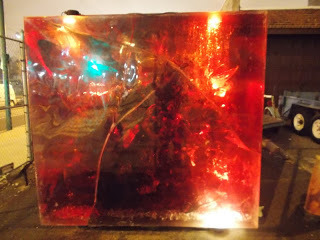
I drove down to Eighth and Callowhill the other night to revisit what is probably the most interesting failed sculpture in Philadelphia.
City Root, by Keiko Miramori was originally commissioned for a park but was rejected because it cracked during the curing process. (Nobody had every done anything quite like it before.) Now it lives in exile in Philadelphia. The new owner has clamped lights to its top which are turned on at night so that it glimmers darkly as you drive by.
The sculpture has become something unintended, a changing reflection on decay and mortality. The cracks have widened enough that you can darkly glimpse bits of root inside. The solid parts of the cube have fractured and fractured again, so that it has filled up with shimmering planes and surfaces, pretty much hiding the roots and the stones and bricks caught up in it.
It was always a beautiful work. But now it's become profound.
You can see my previous blog (with daytime pictures) here.
*

I drove down to Eighth and Callowhill the other night to revisit what is probably the most interesting failed sculpture in Philadelphia.
City Root, by Keiko Miramori was originally commissioned for a park but was rejected because it cracked during the curing process. (Nobody had every done anything quite like it before.) Now it lives in exile in Philadelphia. The new owner has clamped lights to its top which are turned on at night so that it glimmers darkly as you drive by.
The sculpture has become something unintended, a changing reflection on decay and mortality. The cracks have widened enough that you can darkly glimpse bits of root inside. The solid parts of the cube have fractured and fractured again, so that it has filled up with shimmering planes and surfaces, pretty much hiding the roots and the stones and bricks caught up in it.
It was always a beautiful work. But now it's become profound.
You can see my previous blog (with daytime pictures) here.
*
Published on December 04, 2012 14:48
December 3, 2012
This Glitterati Life . . .
.

The group of writers which Tom Purdom refers to as the Philadelphia Writers Group and some of us (well, okay, me) call Purdom's Raiders met for brunch on Saturday.
Sort of visible above are (from left to right): Camille Bacon-Smith, Tom Purdom, Marianne Porter, Gardner Dozois, and Susan Casper. The empty chair is mine. Not visible are Darrell Schweitzer and Mattie Brahan, who hadn't arrived yet.
*

The group of writers which Tom Purdom refers to as the Philadelphia Writers Group and some of us (well, okay, me) call Purdom's Raiders met for brunch on Saturday.
Sort of visible above are (from left to right): Camille Bacon-Smith, Tom Purdom, Marianne Porter, Gardner Dozois, and Susan Casper. The empty chair is mine. Not visible are Darrell Schweitzer and Mattie Brahan, who hadn't arrived yet.
*
Published on December 03, 2012 14:39
December 1, 2012
Pop-up Chicken
.
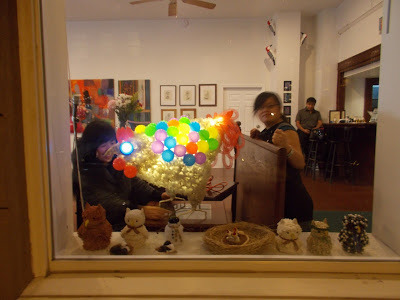
Earlier today I went down to the Bainbridge Club at 1523 Bainbridge Street, here in Philadelphia, for a pop-up art show. One of the artists was a friend, but I've gotta say I liked a good two-thirds of the art, and maybe more. Prices ranged from twenty bucks to several thousand, so there was something there for every wallet.
Ordinarily I don't post on weekends, but the pop-up ends tomorrow (or as you're reading this, probably today) on Sunday, December 2. So I do this as a favor to you. Provided you live in Philadelphia, have tomorrow free, and like this kind of thing. As I do.
Above: A light-up chicken in the window being adjusted by young artists. Young artists are heroes. We should support them.
*


Earlier today I went down to the Bainbridge Club at 1523 Bainbridge Street, here in Philadelphia, for a pop-up art show. One of the artists was a friend, but I've gotta say I liked a good two-thirds of the art, and maybe more. Prices ranged from twenty bucks to several thousand, so there was something there for every wallet.
Ordinarily I don't post on weekends, but the pop-up ends tomorrow (or as you're reading this, probably today) on Sunday, December 2. So I do this as a favor to you. Provided you live in Philadelphia, have tomorrow free, and like this kind of thing. As I do.
Above: A light-up chicken in the window being adjusted by young artists. Young artists are heroes. We should support them.
*
Published on December 01, 2012 20:05
November 30, 2012
Ice! On Mercury!
.

Yesterday NASA announced that, mirabile dictu, they had found ice on the north pole of Mercury, tucked away in the shadowed interior edges of craters where sunlight never reaches. Given that the surface temperature of Mercury can be hot enough to melt tin, that comes as a surprise.
They also found organic (not to be confused with biological) materials on Mercury. These, combined with the water ice, should provide valuable clues to the evolution of the Solar System and possibly even the the origins of life.
But that's not what I and pretty much every other science fiction writer in the world is focusing on. We're all thinking: Fuel. Water ice -- and apparently there's a lot of it -- would make great propulsion mass for a nuclear-powered spaceship. Which means that such a ship could be sent to Mercury at a fraction of the cost that a ship carrying a round trip's supply would.
Which means that a manned expedition to Mercury just got a lot closer in time than it was a week ago. How close depends on how much political will various countries have for a vigorous space program, and whether civilization crashes between now and then. But, with luck, the first men and women to set foot on Mercury may already have been born.
You can read the Guardian article here.
*

Yesterday NASA announced that, mirabile dictu, they had found ice on the north pole of Mercury, tucked away in the shadowed interior edges of craters where sunlight never reaches. Given that the surface temperature of Mercury can be hot enough to melt tin, that comes as a surprise.
They also found organic (not to be confused with biological) materials on Mercury. These, combined with the water ice, should provide valuable clues to the evolution of the Solar System and possibly even the the origins of life.
But that's not what I and pretty much every other science fiction writer in the world is focusing on. We're all thinking: Fuel. Water ice -- and apparently there's a lot of it -- would make great propulsion mass for a nuclear-powered spaceship. Which means that such a ship could be sent to Mercury at a fraction of the cost that a ship carrying a round trip's supply would.
Which means that a manned expedition to Mercury just got a lot closer in time than it was a week ago. How close depends on how much political will various countries have for a vigorous space program, and whether civilization crashes between now and then. But, with luck, the first men and women to set foot on Mercury may already have been born.
You can read the Guardian article here.
*
Published on November 30, 2012 07:57
November 29, 2012
The Origin of "Sword and Sorcery"
.
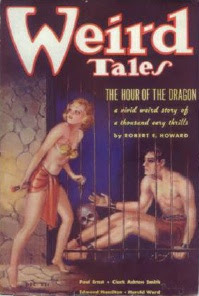
So much that seems obvious to us today was once quite the opposite. I was recently reading It's Down the Slippery Cellar Stairs, a 1984 Chris Drumm chapbook of R. A. Lafferty nonfiction, and came across the following passage:
But back in 1979, when the essay originally appeared, such distinctions were very muddy. The difference between high fantasy and low fantasy (a term which, like S and S, has fallen out of popular use) seemed pretty clear -- high fantasy occurred in a created world and low fantasy occurred in our own. But Lafferty, who was nobody's fool, managed to conflate sword and sorcery with high fantasy and identify them both with heroic fantasy.
This was possible because back then there wasn't a whole lot of scholarship in the science fiction genre (and what there was, tended to be resented; "let's keep science fiction in the gutter, where it belongs" being a common rallying cry) and far less in the fantasy genre. If you wanted to look up a definition of sword and sorcery, you were out of luck.
Unless, that is, you had a copy of the April 6, 1961 issue of Ancalagon .
Ancalagon was what was then known as a "crudzine" -- term pretty much self-defining -- put out by the Philadelphia Science Fiction Society. In it, there appeared a letter from Fritz Leiber, suggesting "sword-and-sorcery as a good popular catchphrase for the heroic fantasy he and fellow fans loved.
The term might well have been forgotten ( Ancalagon had a very small readership, but Philadelphia superfan (and later editor, publisher, agent, and pretty much everything else) George Scithers who got Leiber to expand upon the theme in George's prestigious heroic fantasy zine, Amra :
But why did Leiber choose Ancalagon of all publications to name a sub-genre in? I suspect he wrote more than one letter to more than one zine. That's only speculation, of course. Still . . . it might be worth your while to go through Great-Great-Granddad's stash of fanzines, just in case.
*

So much that seems obvious to us today was once quite the opposite. I was recently reading It's Down the Slippery Cellar Stairs, a 1984 Chris Drumm chapbook of R. A. Lafferty nonfiction, and came across the following passage:
Science Fiction is a collection of guerrilla bands each challenging hte rights of the others to belong to the centrality. The band most challenged by the others is 'high fantasy', sometimes called 'Sword and Sorcery'. There is a lot of stylized sneering at 'S and S'.Which is interesting because today any reasonably read fan of fantasy understands that sword & sorcery is not the same thing as high fantasy. The usefulness of the term is essentially to sort works like Michael Moorcock's Elric stories and Fritz Leiber's tales of Fafhrd and the Gray Mouser into one camp (sword and sorcery) and J. R. R. Tolkien's Lord of the Rings and George R. R. Martin's A Song of Fire and Ice into another (high fantasy). It's a useful distinction because the two groups really are engaged in distinct enterprises. The one is more playful than the other while the other is more serious than the one.
But back in 1979, when the essay originally appeared, such distinctions were very muddy. The difference between high fantasy and low fantasy (a term which, like S and S, has fallen out of popular use) seemed pretty clear -- high fantasy occurred in a created world and low fantasy occurred in our own. But Lafferty, who was nobody's fool, managed to conflate sword and sorcery with high fantasy and identify them both with heroic fantasy.
This was possible because back then there wasn't a whole lot of scholarship in the science fiction genre (and what there was, tended to be resented; "let's keep science fiction in the gutter, where it belongs" being a common rallying cry) and far less in the fantasy genre. If you wanted to look up a definition of sword and sorcery, you were out of luck.
Unless, that is, you had a copy of the April 6, 1961 issue of Ancalagon .
Ancalagon was what was then known as a "crudzine" -- term pretty much self-defining -- put out by the Philadelphia Science Fiction Society. In it, there appeared a letter from Fritz Leiber, suggesting "sword-and-sorcery as a good popular catchphrase for the heroic fantasy he and fellow fans loved.
The term might well have been forgotten ( Ancalagon had a very small readership, but Philadelphia superfan (and later editor, publisher, agent, and pretty much everything else) George Scithers who got Leiber to expand upon the theme in George's prestigious heroic fantasy zine, Amra :
I feel more certain than ever that this field should be called the sword-and-sorcery story. This accurately describes the points of culture-level and supernatural element and also immediately distinguishes it from the cloak-and-sword (historical adventure) story—and (quite incidentally) from the cloak-and-dagger (international espionage) story too!So from the very start, sword and sorcery was defined as being equivalent to heroic fantasy. Leiber did not specify it had to occur in an invented world, so it was not identical with high fantasy, a term which I suspect was invented rather later in the game.
But why did Leiber choose Ancalagon of all publications to name a sub-genre in? I suspect he wrote more than one letter to more than one zine. That's only speculation, of course. Still . . . it might be worth your while to go through Great-Great-Granddad's stash of fanzines, just in case.
*
Published on November 29, 2012 07:20
November 28, 2012
Miss Helen Hope Mrrrlees
.
Today is Miss Helen Hope Mrrrlees's rebirthday. Two years ago to the day, Marianne and I dropped into the Montgomery County ASPCA and fell in love with a tiny little cat we thought was still a kitten. It turned out that Miss Hope was so slight because she was half starved. Over the next couple of months, she almost doubled her weight, becoming . . . a slim, svelte cat.
Miss Hope is a Bengal, a breed created by crossing Asian wildcats with tabbies, and so she's separated from the jungle by only a handful of generations. Bengels have long tails, large eyes, spots, an incredible stretch, and it was only after we got her home that we learned that they're "for experienced cat owners only." Which is to say, they're very active and need lots of attention. Miss Hope is a bit of jock, I'm afraid.
Luckily, Marianne and I have owned many cats over the years, so this is not a problem.
Happy Rebirthday, Miss Hope! I trust you'll consider extending our contract.
Above: No picture of Miss Hope, I'm afraid, because I've used up Google's allowance. As soon as I've figured out how to remove pix from my Picasa file or else resize them, pictures will return.
*
Today is Miss Helen Hope Mrrrlees's rebirthday. Two years ago to the day, Marianne and I dropped into the Montgomery County ASPCA and fell in love with a tiny little cat we thought was still a kitten. It turned out that Miss Hope was so slight because she was half starved. Over the next couple of months, she almost doubled her weight, becoming . . . a slim, svelte cat.
Miss Hope is a Bengal, a breed created by crossing Asian wildcats with tabbies, and so she's separated from the jungle by only a handful of generations. Bengels have long tails, large eyes, spots, an incredible stretch, and it was only after we got her home that we learned that they're "for experienced cat owners only." Which is to say, they're very active and need lots of attention. Miss Hope is a bit of jock, I'm afraid.
Luckily, Marianne and I have owned many cats over the years, so this is not a problem.
Happy Rebirthday, Miss Hope! I trust you'll consider extending our contract.
Above: No picture of Miss Hope, I'm afraid, because I've used up Google's allowance. As soon as I've figured out how to remove pix from my Picasa file or else resize them, pictures will return.
*
Published on November 28, 2012 11:18
November 27, 2012
Writing Advice from Somerset Maugham
.
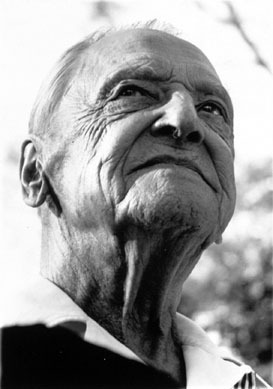
Here's a quote from W. Somerset Maugham. It's taken from the introduction to his collection Creatures of Circumstance , published in 194t7. In the intro, he rails against certain aspects of contemporary short fiction which genre readers and writers are still railing against.
I read some time ago an article on how to write a short story. Certain points the author made were useful, but to my mind the central thesis was wrong. She stated that the "focal point" of a short story should be the building of character and that the incidents should be invented solely to "liven" personality. Oddly enough she remarked earlier in her article that the parables are the best short stories that have ever been written. I think it would be difficult to describe the characters of the Prodigal Son and his brother or of the Good Samaritan and the Man who fell among thieves. They are in fact purely conventional types and we have to guess what sort of people they were, for we are only told about them the essential facts necessary for the pointing of the moral. And that is about all the short story writer can do. He has not room to describe and develop a character; he can only give the salient traits that bring the character to life and so make the story he has to tell plausible. Since the beginning of history men have gathered round the camp fire or in a group in the market place to listen to the telling of stories. The desire to listen to them appears to be as deeply rooted in the human animal as the sense of property.
Every word of this is true and wise, insofar as it applies to the sort of short story he admired. And every word of it is false and wrong-headed insofar as it applies to the sort of short story he despised.
How is this possible? The Master Curmudgeon himself explained it earlier in the essay, when he criticized Chekhov's admonitions on writing: The simple fact is that Chekhov believed what writers, being human, are very apt to believe, namely that what he was best able to do was the best thing to do.
Gonnabe writers should keep this in mind: Advice from writers on how to write the sort of thing they themselves write is usually very good. Their advice on what not to write, however, is always suspect.
Thus endeth today's sermon.
*

Here's a quote from W. Somerset Maugham. It's taken from the introduction to his collection Creatures of Circumstance , published in 194t7. In the intro, he rails against certain aspects of contemporary short fiction which genre readers and writers are still railing against.
I read some time ago an article on how to write a short story. Certain points the author made were useful, but to my mind the central thesis was wrong. She stated that the "focal point" of a short story should be the building of character and that the incidents should be invented solely to "liven" personality. Oddly enough she remarked earlier in her article that the parables are the best short stories that have ever been written. I think it would be difficult to describe the characters of the Prodigal Son and his brother or of the Good Samaritan and the Man who fell among thieves. They are in fact purely conventional types and we have to guess what sort of people they were, for we are only told about them the essential facts necessary for the pointing of the moral. And that is about all the short story writer can do. He has not room to describe and develop a character; he can only give the salient traits that bring the character to life and so make the story he has to tell plausible. Since the beginning of history men have gathered round the camp fire or in a group in the market place to listen to the telling of stories. The desire to listen to them appears to be as deeply rooted in the human animal as the sense of property.
Every word of this is true and wise, insofar as it applies to the sort of short story he admired. And every word of it is false and wrong-headed insofar as it applies to the sort of short story he despised.
How is this possible? The Master Curmudgeon himself explained it earlier in the essay, when he criticized Chekhov's admonitions on writing: The simple fact is that Chekhov believed what writers, being human, are very apt to believe, namely that what he was best able to do was the best thing to do.
Gonnabe writers should keep this in mind: Advice from writers on how to write the sort of thing they themselves write is usually very good. Their advice on what not to write, however, is always suspect.
Thus endeth today's sermon.
*
Published on November 27, 2012 00:00
November 26, 2012
Applegate's Circus of Flying Animals
.

While I was researching a story set in Philadelphia, I came upon the tale of Applegate's Circus of Flying Animals. James R. Applegate was an entrepreneur who had made a fortune with daguerreotype studios. In 1890 bought the First Moravian Church in the Tenderloin district and erected an indoor carousel in the churchyard. A circus of flying animals being simply a poetic way of saying merry-go-round in the newspaper advertisements.
The attraction quickly became a playground for children during the day and adults at night. For one half of the wooden structure housed an enormous theme bar, with waiters dressed as clowns, waitresses in tights, and waiters dressed as circus strongmen. Also prostitutes -- lots and lots of prostitutes. Which was convenient because there were also rooms on the second floor which could be rented by the hour.
Things got lively, the Moravians (who were allowed to stay in their church while they scouted out a new one) were upset, city reformers and the police got involved . . . and the building burned down. James Applegate was on trial for running a disorderly house at the time, but the d.a. cut a deal letting him off with a suspended sentence because many of the young girls working for him had returned to their families and the shock of having to testify might force them back on the streets.
Mr. Applegate was known to be very generous to police officers and other members of the legal community.
This charming story can be found in more detail in Wicked Philadelphia: Sin in the City of Brotherly Love by Thomas W. Keels. A book I am enjoying enormously.
The church and all the neighborhood around it were razed long ago. All that remains is Franklin Square. Which today includes a very nice carousel.
And speaking of tokens . . .
The merry-go-round token above, showing two asses and bearing the evocative slogan When Shall We Three Meet Again? is in the collections of the Smithsonian Institution. Not in the National Museum of American History, as you might expect, but in the National Air and Space Museum.
That word "flying" misled them, apparently.
*

While I was researching a story set in Philadelphia, I came upon the tale of Applegate's Circus of Flying Animals. James R. Applegate was an entrepreneur who had made a fortune with daguerreotype studios. In 1890 bought the First Moravian Church in the Tenderloin district and erected an indoor carousel in the churchyard. A circus of flying animals being simply a poetic way of saying merry-go-round in the newspaper advertisements.
The attraction quickly became a playground for children during the day and adults at night. For one half of the wooden structure housed an enormous theme bar, with waiters dressed as clowns, waitresses in tights, and waiters dressed as circus strongmen. Also prostitutes -- lots and lots of prostitutes. Which was convenient because there were also rooms on the second floor which could be rented by the hour.
Things got lively, the Moravians (who were allowed to stay in their church while they scouted out a new one) were upset, city reformers and the police got involved . . . and the building burned down. James Applegate was on trial for running a disorderly house at the time, but the d.a. cut a deal letting him off with a suspended sentence because many of the young girls working for him had returned to their families and the shock of having to testify might force them back on the streets.
Mr. Applegate was known to be very generous to police officers and other members of the legal community.
This charming story can be found in more detail in Wicked Philadelphia: Sin in the City of Brotherly Love by Thomas W. Keels. A book I am enjoying enormously.
The church and all the neighborhood around it were razed long ago. All that remains is Franklin Square. Which today includes a very nice carousel.
And speaking of tokens . . .
The merry-go-round token above, showing two asses and bearing the evocative slogan When Shall We Three Meet Again? is in the collections of the Smithsonian Institution. Not in the National Museum of American History, as you might expect, but in the National Air and Space Museum.
That word "flying" misled them, apparently.
*
Published on November 26, 2012 07:25
November 23, 2012
Small Egotistical Pleasures
.

Here's an application which, except for the price, I want. At the Omote 3D Shashin Kan portrait studio in Japan, they've combined a 3D printer and a hand-held scanner so that you can have a small plastic figurine of yourself made. They come in three sizes: 10cm for $264, 15cm for $402, and 20cm for $528. Ouch.
Still, what they're buying in Japan is novelty and the services of a professional photographer who knows how to pose you so you look good. In a few years, fingers crossed, we ought to have self-serve kiosks which will give you your figurine for a pair of sawbucks. Sort of like those those photo booths that used to give you ten tiny photos for a buck. I'll confess to looking forward to it -- O brave new world, that has such tchotchkes in it!
You can read the Japan Daily Press article here.
And speaking of Lafferty . . .
The consensus here and on Facebook seems to be that liking R. A. Lafferty's work is not a guy thing. Which, speaking as an admirer of the man, I find a relief. There's also been a certain amount of grumbling at how hard it can be find Lafferty's work.
So I'm pleased to be able to hint that there may be some good news in the offing next year. I'll let you know as soon as I have all the details. Stay tuned!
*

Here's an application which, except for the price, I want. At the Omote 3D Shashin Kan portrait studio in Japan, they've combined a 3D printer and a hand-held scanner so that you can have a small plastic figurine of yourself made. They come in three sizes: 10cm for $264, 15cm for $402, and 20cm for $528. Ouch.
Still, what they're buying in Japan is novelty and the services of a professional photographer who knows how to pose you so you look good. In a few years, fingers crossed, we ought to have self-serve kiosks which will give you your figurine for a pair of sawbucks. Sort of like those those photo booths that used to give you ten tiny photos for a buck. I'll confess to looking forward to it -- O brave new world, that has such tchotchkes in it!
You can read the Japan Daily Press article here.
And speaking of Lafferty . . .
The consensus here and on Facebook seems to be that liking R. A. Lafferty's work is not a guy thing. Which, speaking as an admirer of the man, I find a relief. There's also been a certain amount of grumbling at how hard it can be find Lafferty's work.
So I'm pleased to be able to hint that there may be some good news in the offing next year. I'll let you know as soon as I have all the details. Stay tuned!
*
Published on November 23, 2012 00:00
November 21, 2012
A Question About R. A. Lafferty and Women
.
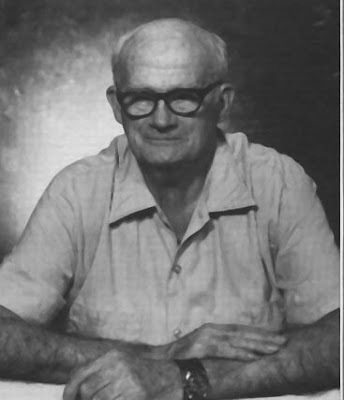
I spent most of the day writing and almost didn't post a blog because, mirabile dictu, nothing worth writing about happened to me today.
But then, for an essay I'm writing, I went looking for quotes about R. A. Lafferty and noticed something strange. Almost everything I came up with had been written by men.
So here's my question: Is Lafferty's work a guy thing?
I'd be unhappy to discover that it was. But either way, I need to know.
What's your experience?
*

I spent most of the day writing and almost didn't post a blog because, mirabile dictu, nothing worth writing about happened to me today.
But then, for an essay I'm writing, I went looking for quotes about R. A. Lafferty and noticed something strange. Almost everything I came up with had been written by men.
So here's my question: Is Lafferty's work a guy thing?
I'd be unhappy to discover that it was. But either way, I need to know.
What's your experience?
*
Published on November 21, 2012 14:16
Michael Swanwick's Blog
- Michael Swanwick's profile
- 546 followers
Michael Swanwick isn't a Goodreads Author
(yet),
but they
do have a blog,
so here are some recent posts imported from
their feed.



